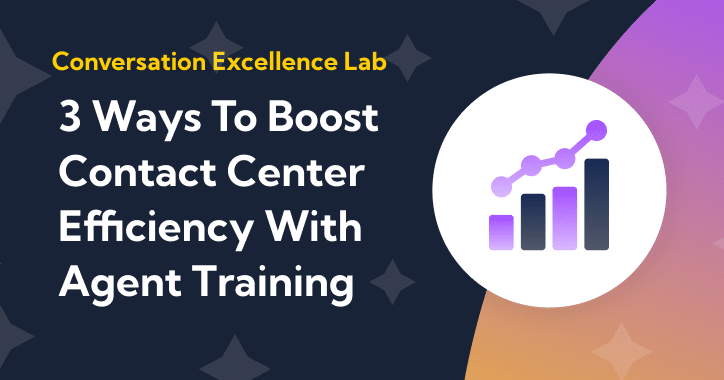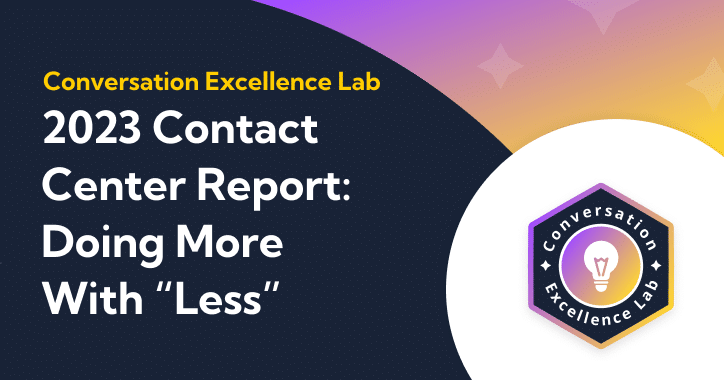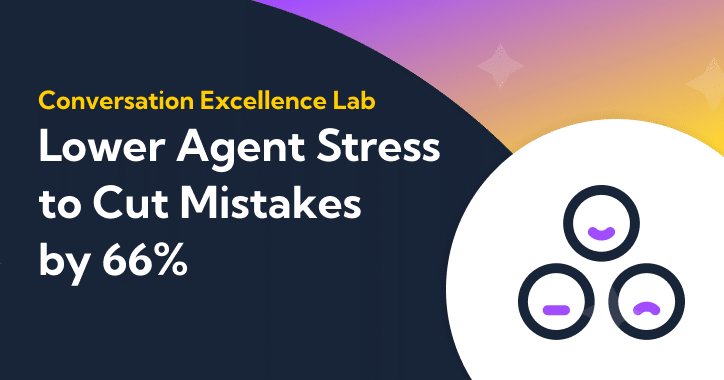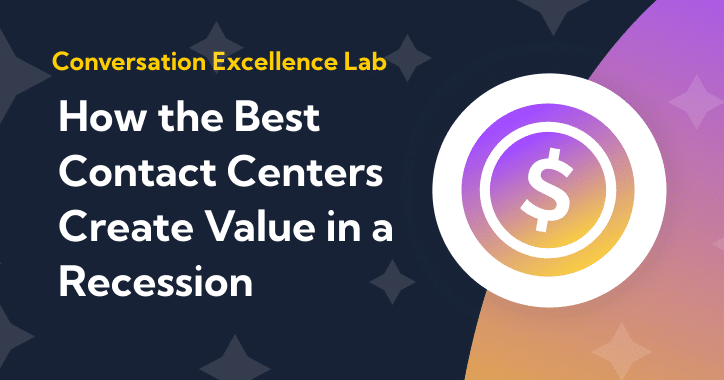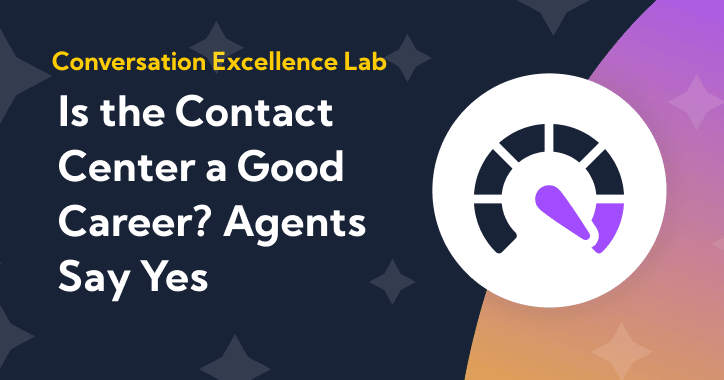The contact center of 2023 shows a marked difference from the contact center of years past. A paradigm shift heralded by post-pandemic growth in AI has changed operational priorities, technological advances, and the role of the agent in a rapid period of time.
Where do we stand now? For contact centers, is artificial intelligence new and cutting-edge, or table stakes? And as we look forward to 2024, let’s ask ourselves: behind all the flash and glamor, what kind of ROI are contact centers actually seeing from AI tools?
We talked to over 400 contact center managers and leaders to understand the past, present, and future of contact center AI.
Here’s what we learned:
- More contact centers are using AI tools now than ever before, and there has been a massive jump in usage over the past year from 59% to 90%.
- In terms of the Gartner Hype Cycle, AI tools have reached the peak of inflated expectations and are now becoming mainstream in the contact center industry.
- As AI tools become table stakes, the benchmark for contact center metrics like AHT, CSAT, conversation rate, and more will change, and those who don’t utilize AI will risk falling behind.
- Many contact center tools, including call guidance software, have started to reach perceived maturity, while others, like omnichannel platforms, still need more time to develop.
- While early adopters of AI were not attuned to ROI, most of our respondents today (75.56%) reported that they did see the ROI of the AI tools they were using, often in terms of increased revenue for their organization.
- Agent, customer, and leadership perceptions of AI were fairly positive, with scores between 7 and 8 on a scale of 1 to 10, supporting an optimistic view of how AI tools can support both contact center operations as a whole and the agents themselves.
Get a Copy of the Report in Your Inbox
Read the results on your own time or share them with your team. No strings attached.
Subscribe for weekly insights from the Conversation Excellence Lab
Who’s Using AI in Contact Centers?
In our 2023 Contact Center Efficiency Report, we found that 40% of our respondents were more interested in AI tools now than they were 12 months ago — but the majority of our respondents (59%) were not actively using AI tools.
They were, however, interested in doing so. A little less than half of those who were not using AI at the time were planning to implement AI in the following 12 months, with another significant segment saying they were interested in doing so but needed support from leadership.
That report came out in April 2023, with data gathered in late February 2023. Now, half a year later, it seems that the prediction of our earlier report has come true: those who were planning to implement AI have succeeded in doing so.
Of our over 400 surveyed managers and leaders, 90% were using AI today. The magnitude of the change between our April report and these results cannot be understated. 35% more contact center leaders are using AI today than they were a mere six months ago.
The tools our respondents were using included chatbots (57.96%), quality assurance software (45.84%), and call guidance software (42.28%). The least used tools were omnichannel platforms (20.67%), sentiment analysis tools (24.7%), and call coaching software (30.17%).
Figure 1: Which AI tools are your contact center currently using?
According to Gartner, more than half (59%) of customer service and support leaders plan to devote more resources to improving, automating, or eliminating inefficient processes in the near future, and that AI may reduce contact center costs by up to $80 billion by 2026 and $240 billion by 2031. Another report posits that 91% of contact center leaders are making automation a critical priority in the upcoming year.
AI may still be the new kid on the block, but it’s a popular kid at that. Soon, it will be table stakes, and contact centers would be best advised to consider their AI options in order to prevent falling behind the competition.
Is Contact Center AI All Hype?
“One of the hardest things about today’s AI hype is that some of the hype is actually real,” says Balto founder and CEO Marc Bernstein. “Distinguishing real from hype is exhausting.”
The Gartner Hype Cycle is used to evaluate emerging technologies within the context of their industry and individual appetite for risk. An understanding of hype cycles can help leaders separate the excitement from a technology’s real promise, reduce their risk, and incorporate the research of experienced analysts into their business decisions.
Gartner explains their hype cycle methodology:
- Innovation Trigger: A potential technology breakthrough kicks things off
- Peak of Inflated Expectations: Early publicity produces a number of success stories — often accompanied by scores of failures
- Trough of Disillusionment: Interest wanes as experiments and implementations fail to deliver
- Slope of Enlightenment: More instances of how the technology can benefit the enterprise start to crystallize and become more widely understood
- Plateau of Productivity: Mainstream adoption starts to take off
Where does AI land in this hype cycle today?
The 2023 Gartner Hype Cycle for Artificial Intelligence places us squarely in the peak of inflated expectations with generative AI, staring down into the trough of disillusionment, where businesses are implementing AI with mixed results and facing some disappointment in light of their aspirations.
But this isn’t necessarily bad news, because soon comes the slope of enlightenment where AI’s use cases will be ironed out and its ability to provide value will be concretized. After that comes the plateau of productivity, where the paradigm shift of AI will be thoroughly normalized into contact center operations and criteria for assessing provider value will be more clearly defined and widely available.
During this period of positive plateau, the benchmarks that define contact center metrics will be irrevocably shifted. Indicators like first call resolution, average handle time, conversion rate, and more will find new points of stability with the support of AI, and those who have not yet implemented AI may not be able to effectively compete in this new landscape.
Consider the fact that contact center agents using AI can handle over twice as many calls, according to a survey by Dialpad. Those agents who don’t benefit from the support of AI will have a difficult time managing call intake at the same level of efficiency. On top of that 71% of customers expect businesses to already know why they are calling — and this type of intelligence is time-consuming and operationally intensive to implement without the assistance of AI and/or automation tools.
How do contact center employees feel about the hype? We asked our respondents how they thought contact centers would change as a result of AI, and the results were fairly evenly distributed. About a third thought that contact centers would change for the better (36.02%), a third thought they would change for the worse (32.61%), and another third felt neutral about the prospect (31.37%).
Figure 2: In the next 10 years, how do you feel about contact centers changing as a result of AI?
Another survey suggested that 77.79% of contact center respondents feel optimistic about AI, suggesting that our neutral cohort may in fact lean positive. Another 66% of respondents in the aforementioned survey said that using AI had a positive impact on their business performance.
It is yet to be seen what the contact center of 2030 will look like with AI in the mix, but there is reason to be optimistic.
Which contact center AI tools are mature enough to use?
The applications and depth of AI usefulness have not yet been fully plumbed. New capabilities are emerging daily while existing capabilities are being further developed and matured in record time. Contact center leaders have a plethora of options when it comes to how to apply AI in their contact center — but which applications are mature enough to truly make a difference?
We asked our over 400 respondents which of the following AI tools and applications were mature enough to provide value to their organizations today:
- Chatbots
- Omnichannel platforms
- Sentiment analysis tools
- Interactive voice response (IVR)
- Voice bots
- Call guidance software
- Call coaching software
- Quality assurance software
The most mature technologies were chatbots (47.71%), call guidance software (45.41%), and quality assurance software (42.82%), while the least mature technologies were omnichannel platforms (30.14%), sentiment analysis tools (32.85%), and voice bots (36.21%).
Figure 3: Which of the following AI tools or applications do you believe are mature enough to be useful today?
Responses did not show a huge variance overall, and had a range of 30-48% in terms of maturity agreement, which suggests that respondents may not have the level of understanding to know when, how, and what it means for an AI tool to have reached maturity. It’s admittedly difficult to picture what a technology may be capable of in the future, especially when one is entrenched in its present applications.
We also asked our respondents which tools they believe will be most important 10 years from now, and they responded that online chatbots will be even more important than they are today, and more emphasis will be placed on IVR and mobile apps for communication with prospects and customers.
Today, the least important AI tools are discussion forums, texting, and self-service knowledge bases, and these were predicted to be broadly the same in 10 years. Notably, live chat with a human was predicted to become less important in the next decade.
Figure 4: Please rank the tools in order of how often they are used today, and your prediction for the same in 10 years. (Note: The lower the number, the more the tool is used.)
Another aspect of measuring application maturity is an understanding of the inherent limitations that AI tools bring with them, such as hallucinations, data biases, privacy concerns, and more. The highest areas of concern for respondents included potential biases in their data (67.3%) as well as data inaccuracies (67.26%), and the perceived high costs of implementing AI (60.71%).
Of least concern to respondents were AI hallucinations (38.66%) which occur when AI models generate confident but fictitious responses, data, or content in response to queries. This lower concern score could point towards a lack of awareness or an understanding that these hallucinations can and will be moderated in further iterations of AI tools.
Figure 5: How concerned are you about these limitations of AI tools?
Another 63.55% of respondents were concerned about the idea that AI could automate more contact center jobs. When Senator Richard Blumenthal asked OpenAI’s chief executive Sam Altman what his biggest nightmare with AI was, Altman responded: “[That] there will be an impact on jobs.”
But those embedded directly in the contact center world have a different take. Nicole Rafferty, who leads AT&T customer care operations, said: “We’re always going to need in-person engagement to solve those complex customer situations… that’s why we’re so focused on building AI that supports our employees.”
The New York Times continues: “Economists studying AI have argued that it most likely won’t prompt sudden widespread layoffs. Instead, it could gradually eliminate the need for humans to do certain tasks — and make the remaining work more challenging.”
Interestingly, those respondents who were using no AI tools at all were the most concerned about AI tools automating jobs. This relationship could be causal in a number of directions: either these respondents’ fear is holding them back from using these tools in the first place, or their lack of usage of this tool is leading to and underscoring this fear. Perhaps those who are actively using AI tools, and have seen how these tools empower and enable their agents, are best suited to opine on the utility and limitations of the tools themselves. Unfortunately, however, none of us has a crystal ball, and there is an element of “wait and see” when it comes to how these capabilities will develop in relation to existing and future agent roles.
Gartner projects that one in ten agent interactions — note: not one in ten agents — will be automated by 2026. In a decade, that number may rise to one in three agent interactions. But AI-supported interactions do not equal interactions that eliminate the need for an agent altogether. This future implies the continued presence and importance of agents, merely leveled up with AI capabilities by their side.
“The role of contact center agents will become increasingly focused on providing personalized and complex solutions powered by AI.”
– Survey Respondent
Do AI tools deliver ROI today?
The premise of the trough of disillusionment on Gartner’s Hype Cycle is that AI products will not deliver the ROI that users expect from them. We talked to over 400 contact center managers and leaders to understand what kind of ROI they were seeing from their AI tools today.
Surprisingly or unsurprisingly, a significant percentage of them were not measuring ROI at all (13.49%). And those who were least likely to measure ROI were also most likely to have started using AI tools over a year ago. This makes sense: early adopters may be attracted by innovation and the opportunity to try something new, without a rigorous eye towards testing this nascent technology against the grindstone of a bottom line.
The smallest and largest contact centers surveyed were also the least likely to measure the ROI of their AI tools, perhaps because they didn’t have the resources to do so (smallest) or they had enough resources to continue using the tools without scrupulous review (largest). Those in mid-sized contact centers seemed to occupy a gray area where they had enough resources to try out new technologies, but didn’t have the level of bureaucracy to necessitate a stringent validation process of this technology.
Figure 6: Have AI tools provided ROI in your contact center?
But the good news is that for the most part, a majority of respondents saw ROI (75.56%). Those who had started using AI tools in the past 1-6 months were the most likely to see ROI, followed by those who implemented AI in the past 6-12 months. Those who implemented AI tools less than a month ago and those who implemented it over 2 years ago were the least likely to see ROI.
The former were not using the AI tools for long enough to adequately measure ROI, and the latter were early adopters who had not prioritized proving value at the time of implementation.
The number one way that respondents measured ROI was through increases in company revenue (43.12%) followed by faster agent onboarding (13.76%) and increased conversion rates (11.62%). The least common ways were through specific KPIs (1.22%), the ability to decrease headcount (1.53%), decreased after-call work (2.45%), and improved QA scorecards (2.45%).
Figure 7: How are you primarily measuring the ROI of your contact center AI tools?
The fact that so few contact center leaders were using AI to decrease headcount (1.53%) should be welcome news to those who fear AI’s potential to automate jobs. This number tells us that outright automation is not a priority today; increasing the bottom line — i.e. widening the pie — is where AI tools are being focused.
The tools with the highest ROI were sentiment analysis tools (91.35%), omnichannel platforms (89.66%), and call guidance software (87.08%). Interestingly, the first two of these three were also among the most immature technologies according to respondents.
This can be interpreted in a few ways. At face value, it is not contradictory to find high levels of ROI in a tool that still has room to grow — both things can be true, as immaturity does not mean that a tool is not valuable. But it is also worth considering that the more someone uses a tool, the more they may become attuned to its exact areas for growth. If a contact center manager has never used a tool, they may not be able to opine on its maturity levels. Therefore, users of sentiment analysis and omnichannel platforms, through their deep usage of these tools, may inherently understand the room for further development and maturity in their use cases.
Respondents were least likely to find ROI with chatbots (80.74%) and quality assurance platforms (82.38%), but there was not a remarkable variance between the most- and least-ROI-producing technologies, suggesting that even those who purport to measure ROI may not feel utter confidence in their ability to do so. More research and data is needed in this regard.
How do agents feel about AI tools?
We asked over 400 contact center managers and leaders: on a scale of 1-10, how supportive is your company’s leadership in embracing AI tools? The average response was 7.47 out of 10. We also asked about customer perception, which was rated even higher at 7.58 out of 10.
“I think that customers will have AI conversations with a more open mind and AI will be more effective.”
– Survey Respondent
While still high, agent support for AI was rated the lowest at 7.21 out of 10. The highest level of agent support for AI occurred in medium-sized teams and the lowest support came from the smallest contact centers, where agents were least likely to have exposure to these types of technologies. The same trend was true for leadership support.
Figure 8: How supportive is your company’s leadership, agents, and customer base in embracing AI tools?
We asked our respondents: in the next 10 years, how do you think the role of a contact center agent will change as a result of AI? For 53.99% of respondents, there was a general idea that agents would be replaced or that there would be fewer of them.
One respondent shared: “Unfortunately, that [agent] role will probably change to nonexistent. With the usage of AI growing in contact centers and becoming standard, its abilities and capabilities are also growing. Therefore, the need for a human is less and less necessary. A person will of course always be needed to run the AI programs to ensure they work correctly. Computers, no matter how advanced, will always require a human to maintain it. But not much more than that. It’s a little scary, isn’t it?”
Is it scary? Most of our respondents were currently using AI for back-end functions like analytics. Newer AI adoptees had a higher percentage of usage of CRM tools and QA tools as well. This suggests that contact centers today are using AI to support agents, but more than that, to automate processes — not jobs.
“When I first started my job in a call center twenty years ago, people were already talking about how technology and automated processes were on the verge of replacing human agents. Today, with artificial intelligence (AI) blossoming in every direction, that familiar refrain about technology replacing human agents is stronger than ever. Except that it won’t. Not yet, at least,” says Jennifer Lee, Chief Operating Officer at Intradiem. “No matter how fast and smart technology becomes, it will never be a satisfying substitute for a human-to-human connection during high-stakes moments of truth in customer interactions.”
At least at the onset of AI utilization, it is lower-risk to implement AI tools on internal functions like CRMs or QA rather than on prospect- or customer-facing functions like chatbots or omnichannel solutions. These internal tools can help organizations test the waters and uncover ROI before they evaluate where else they’d like to implement AI in their internal and external infrastructure.
Efficiency is still the name of the game, and that doesn’t necessarily mean replacing agents.
“Technology really does affect the way human beings work. But customer service isn’t a zero-sum game where additional input from technology must come at the expense of human workers. It’s not about how to divide the pie; it’s about how to expand it,” says Jennifer Lee.
We may even be nearing a landscape where having real agents on the phones is the utmost customer service differentiator. While the most cutthroat corporations may look to completely remove human agents from the equation to save money, customers will know that those who retain their agents and who can provide a conversation with a human are those who truly value their experience. These are the companies that will stand out as customer-first and meet the test of time.
“I think much of this role can become automated HOWEVER, I think the most essential element of human interaction is when there are issues. Our call agents handle these issues so much better than AI ever could!”
– Survey Respondent
When asked how they thought the role of the agent would change in the next 10 years, 27.91% of our respondents were confident that AI would support agents in doing their jobs better and in a more streamlined way. Another 13.8% shared that they were excited for AI to take over much of the grunt work so agents could upskill and have new opportunities. Combined, this 41.72% of respondents draw close to the 53.99% who had agent automation in mind.
Figure 9: In the next 10 years, how do you think the role of a contact center agent will change as a result of AI?
Another survey shows that 60% of customer service agents say that AI helps them save time. AI helps customer service representatives save time in a way that adds up, and lets them use that time to answer more calls and provide better service.
Additionally, nine out of ten agents want to see more aspects of customer interactions automated, from conversation summarization to disposition notes; knowledge searches to bill payment logistics.
At the same time, agents remain optimistic about the growth available to them in the contact center. In our February 2023 report “Is the Contact Center a Good Career? Tenured Agents Say Yes” we found that 68% of tenured agents were actively working towards a promotion and 84.7% were taking on additional management responsibilities.
To underscore the idea that customers don’t want to lose that human engagement: by 2026, Gartner predicts that 75% of customers will call service lines due to loneliness, not because they have a customer service concern. We remain bullish on the fact that AI can’t help with these types of customer needs, no matter how advanced it becomes.
In the not-so-far future, agents will have to expertly navigate conversations while exhibiting high emotional intelligence and soft skill usage — and AI will be there to help them automate away the scut work so they can focus on these high-value interactions and build customer loyalty in the process.
In the future we’re discussing, there may very well be fewer agents in some capacities, but not across the board. The smallest contact centers in our survey even reported that they were looking to hire more agents in the next decade. Only the largest contact centers said they wanted to shrink their operations. And even if they do so, there will still be a need for the remaining agents to be vastly upskilled and ready to handle the complex interactions that AI cannot — and will not — be able to handle.
Conclusion
In the last six months, the percentage of contact centers that reported using AI tools has jumped from 59% to 90%. Very soon, AI tools will be table stakes in the contact center — in fact, they are already starting to be. Contact centers must take the time to evaluate their AI capabilities to protect against falling behind as we approach a positive plateau of normalization for AI capabilities.
And as AI tool usage becomes more and more mainstream, attention has turned towards understanding how and to what extent these tools deliver ROI. Early AI adopters were the least likely to measure ROI, while those who implemented AI in the last year were the most likely to put resources towards measuring ROI. Overall, the ROI was there. 75.56% of respondents found ROI with AI tools, mostly in terms of their organization’s increased revenue.
When asked what they fear the most with AI, many of our respondents talked about the automation of the agent role. Many others, however, including industry leaders and economists, were optimistic that AI will not outright automate the agent role, or other jobs for that matter. Rather, AI will be able to automate processes and support agents so they can focus on the interactions and the functions that matter most, and improve the customer experience and their organizations’ bottom line in the meantime.
Demographics
We surveyed 421 contact center leaders for this survey. We only allowed respondents with the title of manager or above to participate in this survey. 60.33% of our respondents were managers and the remaining 39.67% were directors, vice presidents, or c-suite executives of a contact center.
The most represented age group among our respondents was 35-44 (40.14%), followed by 25-34 (30.17%) and 45-54 (18.76%). Those aged 55+ were the least represented as 10.93% of the survey population.
Figure 10: How old are you?
The gender representation of our survey was closely split at 53.92% male and 46.08% female. Tenures ranged from <6 months (0.95%) all the way to 10+ years of work (26.13%) at a given organization. The most represented tenure level was 10+ years followed by 3-5 years (24.23%) and the least represented tenure was <6 months followed by 6-12 months (3.09%).
In terms of department, operations made up 42.28% of our respondents followed by customer service (29.45%) and sales (14.01%).
Figure 11: What best describes the department you work in?
Company size varied tremendously. Those with 501-1,000 agents made up 23.99% of our respondents, followed closely by those with 101-500 agents (22.80%). The least represented company sizes included those with 10,001+ agents (4.51%) and those with <20 agents (7.13%).
Figure 12: How many agents work at your company?
Over 20 industries were represented in our report, including retail (16.86%), technology (12.59%), manufacturing (10.69%), and healthcare (9.26%). The least represented industries were utilities (0.48%) and home improvement (0.71%).
Figure 13: Which industry best describes the company you work for?
Methodology
This research was conducted in collaboration with third-party research firm Centiment in August 2023.
Survey participants were all given a screening question to determine whether or not they fit into the criteria for participation in the survey: “Which of the following best describes your job?” If their response did not signify that they were a manager, director, vice-president, or c-suite of a contact center, they were disqualified.
Respondents were asked to answer 30 questions, including 6 demographic questions where respondents were asked to self-report on their gender, age, tenure, industry, etcetera. The remainder of the questions centered around the content of this report: AI usage and perception in the past, present, and future.
The survey included an attention check at the midpoint to ensure that respondents were fully attending to the content of the survey. Those who did not respond correctly to the attention check were disqualified from the survey and their results were not included in the survey findings.
The sample population spanned a wide range of executive experience levels, industries, departments, age groups, and other demographic parameters.
Sources
Balto. (2021, December 13). What Does the Contact Center of 2030 Look Like? – Balto AI. RSS. Retrieved from https://www.balto.ai/blog/what-does-the-contact-center-of-2030-look-like/
Balto. (2023, February 6). Is the Contact Center a Good Career? Tenured Agents Say Yes – Balto AI. RSS. Retrieved from https://www.balto.ai/research/is-the-contact-center-a-good-career/
Balto. (2023, April 20). 2023 Contact Center Report: How Contact Center Leaders Are Improving Efficiency and Doing More With “Less” – Balto AI. RSS. Retrieved from https://www.balto.ai/research/2023-contact-center-efficiency-report/
Balto. Real-Time Coaching. Retrieved from https://www.balto.ai/real-time-coaching/
Balto. Real-Time Guidance. Retrieved from https://www.balto.ai/real-time-guidance/
Balto. Real-Time Notetaker. Retrieved from https://www.balto.ai/real-time-notetaker/
Balto. Real-Time QA. Retrieved from https://www.balto.ai/real-time-qa/
Bernstein, M. (2023, August). LinkedIn. Retrieved from https://www.linkedin.com/posts/baltoceo_one-of-the-hardest-things-about-todays-ai-activity-7097955252129206272-F74p/?utm_source=share&utm_medium=member_desktop
Gallagher, J. (2022, June 16). ASAPP CX Report Reveals 85% of Customer Service Agents Don’t Want to Return to Contact Centers, Work from Home Could Be Permanent. Global Newswire. Retrieved from https://www.globenewswire.com/en/news-release/2022/06/16/2464212/0/en/ASAPP-CX-Report-Reveals-85-of-Customer-Service-Agents-Don-t-Want-to-Return-to-Contact-Centers-Work-from-Home-Could-Be-Permanent.html
Gartner. Gartner Hype Cycle. Retrieved from https://www.gartner.com/en/research/methodologies/gartner-hype-cycle
Goldberg, E. (2023, July 22). ‘Training My Replacement’: Inside a Call Center Worker’s Battle with A.I. The New York Times. Retrieved from https://www.nytimes.com/2023/07/19/business/call-center-workers-battle-with-ai.html
Invoca. (2021). Invoca Buyer Experience Benchmark Report. Retrieved from https://explore.invoca.com/buyer-experience-benchmark-report/
Lee, Jennifer. (2023, March 27). How Can AI Fit Into Customer Service Call Centers Effectively? Forbes. Retrieved from https://www.forbes.com/sites/forbesbusinessdevelopmentcouncil/2023/03/27/how-can-ai-fit-into-customer-service-call-centers-effectively/?sh=390440ee3fee
Morrison, R. (2022, October 27). AI in call centres could save businesses $80bn. Tech Monitor. Retrieved from https://techmonitor.ai/technology/ai-and-automation/call-centre-ai
Perri, L. (2023, August 17). What’s New in Artificial Intelligence from the 2023 Gartner Hype Cycle. Gartner. Retrieved from https://www.gartner.com/en/articles/what-s-new-in-artificial-intelligence-from-the-2023-gartner-hype-cycle
Replicant. (2022). 2022 Benchmark Report: Automation in the Contact Center. Retrieved from https://www.replicant.com/resources/guides/2022-benchmark-report-automation-in-the-contact-center/
Rimol, M. (2022, August 31). Gartner Predicts Conversational AI Will Reduce Contact Center Agent Labor Costs by $80 Billion in 2026. Gartner. Retrieved from https://www.gartner.com/en/newsroom/press-releases/2022-08-31-gartner-predicts-conversational-ai-will-reduce-contac
Stevenson, R. (2022, February). AI in customer service 2022: What CS professionals really think. Dialpad. Retrieved from https://www.dialpad.com/blog/ai-customer-service-report/

